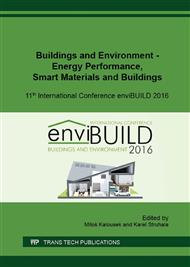p.239
p.247
p.255
p.263
p.271
p.279
p.287
p.295
p.303
Dynamic Heat and Moisture Transport Modeling of Industrial Floors on Different Climates
Abstract:
In this paper a conjugated heat and moisture transport investigation of industrial floors is presented. We have analyzed 2D general segments of wall and foundation connections in three different climatic conditions: Budapest (Hungary), Lisbon (Portugal) and Espoo (Finland). We also modeled the component with horizontal or vertical edge insulations with various thicknesses and lengths, and two different soil compositions under the floors. The design of the floor and wall components was performed according to the current standards. We examined 126 combination of the segment and the results shows difference both in relative humidity across the components and heat losses through the internal faces. In conclusion, the simulations and results can improve the energy efficient design of industrial buildings across Europe.
Info:
Periodical:
Pages:
271-278
Citation:
Online since:
December 2016
Authors:
Price:
Сopyright:
© 2017 Trans Tech Publications Ltd. All Rights Reserved
Share:
Citation:


